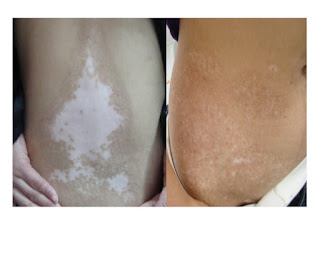Many physicians, and even some dermatologists, fail to recognize the profound
social and psychological impact vitiligo may have on its victims. Vitiligo is
painless and non-pruritic and, unlike psoriasis, it is not associated with
shedding of skin scales. But the disfigurement of vitiligo, accentuated among
persons with brown or black skin, can be devastating.
The recent media publicity about Michael Jackson's battle with vitiligo has helped raise public awareness of the disease. While vitiligo is worldwide and affects all races equally, it is a particularly troubling social problem for persons whose normal skin color is brown or black. The contrast between brown skin and white vitiligo spots can create a grotesque "harlequin" appearance. The same kind of disfigurement can become a problem for vitiligo victims with normally fair skin who tan deeply during the summer months or, among those who live in sunny climates, throughout the year.
In India, vitiligo, or "leukoderma" as it is called there, is regarded as "white leprosy." The late Prime Minister Jawaharlal Nehru ranked vitiligo as one of three major medical problems in India, alongside malaria and leprosy. A woman in India cannot marry if she has even one spot of vitiligo, and if a woman develops vitiligo after marriage it is considered grounds for divorce.
It is no wonder vitiligo patients can turn aggressive, feel a sense of shame, or become withdrawn and resentful. For many, vitiligo is not just a cosmetic problem-it is a major social dysfunction that seriously curtails their ability to lead a normal work, social or married life. Reversal of the white spots and restoration of normal skin color is therefore the primary hope for all these disfigured vitiligo patients.
The recent media publicity about Michael Jackson's battle with vitiligo has helped raise public awareness of the disease. While vitiligo is worldwide and affects all races equally, it is a particularly troubling social problem for persons whose normal skin color is brown or black. The contrast between brown skin and white vitiligo spots can create a grotesque "harlequin" appearance. The same kind of disfigurement can become a problem for vitiligo victims with normally fair skin who tan deeply during the summer months or, among those who live in sunny climates, throughout the year.
In India, vitiligo, or "leukoderma" as it is called there, is regarded as "white leprosy." The late Prime Minister Jawaharlal Nehru ranked vitiligo as one of three major medical problems in India, alongside malaria and leprosy. A woman in India cannot marry if she has even one spot of vitiligo, and if a woman develops vitiligo after marriage it is considered grounds for divorce.
It is no wonder vitiligo patients can turn aggressive, feel a sense of shame, or become withdrawn and resentful. For many, vitiligo is not just a cosmetic problem-it is a major social dysfunction that seriously curtails their ability to lead a normal work, social or married life. Reversal of the white spots and restoration of normal skin color is therefore the primary hope for all these disfigured vitiligo patients.

